Quasars are the brightest and most distant recorded objects in the visible Universe. The light emitted comes from the accretion disk around supermassive black holes.
Key Facts & Summary
- Quasars belong to a family of objects known as active galactic nuclei or AGN.
- Their actual name is shortened. They stand for Quasi-Stellar Radio Sources.
- Most Quasars are at least 100 times more luminous than our Milky Way galaxy.
- Because of their great brightness, they tend to outshine the ancient galaxies in which they reside.
- More than 200.000 Quasars have been discovered. The first was discovered in 1950, and it was named 3C 273.
- Around 10% of the known quasars emit strong radio waves.
- Many of the charged particles inside the quasar jets reach speeds that are very near the speed of light. Because of this, they are visible from incredibly long distances and as such, are among the brightest objects in the universe.
- There is a supermassive black hole behind every Quasar, but not every black hole is a quasar.
- Most of the discovered quasars are billions of light-years away from us. This makes them the most distant objects to be discovered.
- Quasars emit energy levels of around millions, billions, or even trillions of electron volts. Many times more than entire galaxies.
- Usually, the supermassive black holes behind quasars have millions to billions of times the mass of our Sun.
- These supermassive black holes are surrounded by a solar system-sized whirlpool of superheated plasma which shines brighter than entire galaxies.
- Quasars played a great role in the shaping of the Universe. They decreased the active star formation by heating up gas. Hot gas cannot collapse and form new stars. This occurred in a period of violent star formation and as such, helped to quell it down.
- It is possible that when the Andromeda and Milky Way galaxies collide, the supermassive black holes will merge and create a new quasar.
Quasars were identified relatively recent and our journey of understanding them has just begun. The first quasars were identified in the 1950s as sources of radio-wave emission of unknown origin.
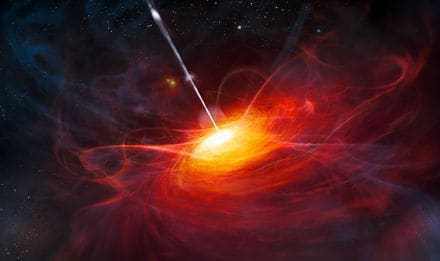
When they were identified in photographic images at visible wavelengths, they appeared as faint star-like points of light. As the technology evolved, the Hubble Space Telescope captured many high-resolution images of quasars.
This helped to demonstrate that quasars occur in the centers of galaxies or the merging of galaxies. Many factors influence the properties of the quasar, such as the mass of the black hole, the rate of accretion, the orientation of the accretion disk relative to the observer, the presence or absence of a jet, and the degree of obscuration by gas and dust within the host galaxy.
Quasars are astrophysical phenomena that are thought to occur in young galaxies where there is a lot of material to fuel the quasar.
Formation
Studies suggest that quasars were very common in the distant past. The quasar epoch happened around 10 billion years ago when violent star formation was active. Galaxies produced stars at a very rapid rate, and some of the very rich gas supplies from back then, most certainly found their way into the nuclei of galaxies, where it encountered supermassive black holes.
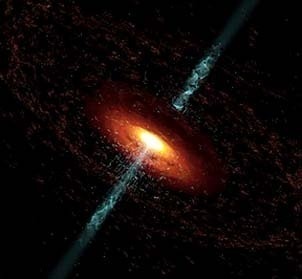
As such, the accretion disks formed, and many new quasars were born. Basically, quasars form when supermassive black holes feed on an abundant matter such as gas or dust. This results in a massive output of energy.
Properties – Characteristics
Quasars existed in the early age of the universe and some exist in young galaxies that have enough material to create them. The real power behind quasars are the supermassive black holes.
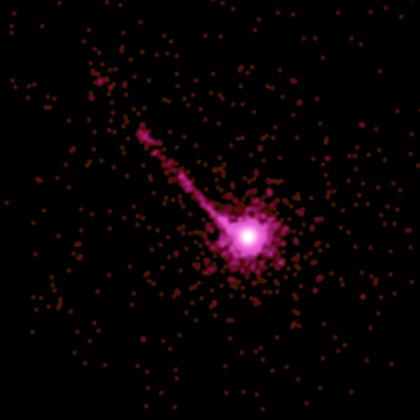
They are immensely bright – for example – 3C 273 is around 4 trillion times brighter than our Sun. If it would be just 33 light-years away from us, it would act/appear as our sun.
Quasars emit radiating energy in all directions but those that have jets, radiate primarily in their direction. Their light is variable and the mass that falls into the black hole is converted around 6% to 32% into energy. This process is unique due to its high-power creation, in a long period of time.
Subtypes of Quasars
There are many subtypes of quasars that display distinct properties. In no particular order:
* Radio-loud quasars – One characteristic is their powerful jets that have strong sources of radio-wavelength emission. Around 10% of the overall quasar population is made up of this subtype of a quasar.
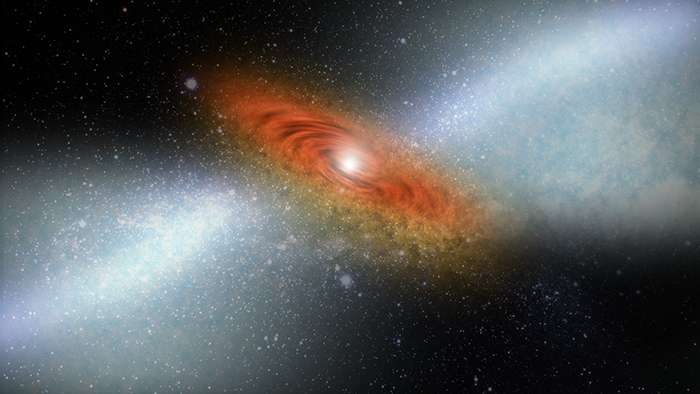
* Radio-quiet quasars – The exact opposite – having weak or lacking powerful jets thus they have relatively weaker radio emissions. Most of these quasars, around 90%, are radio-quiet.
* Broad absorption-line (BAL) quasars – their spectra exhibit broad absorption lines that are blueshifted relative to the quasar’s rest frame. Broad absorption lines are found in around 10% of quasars and are usually radio-quiet.
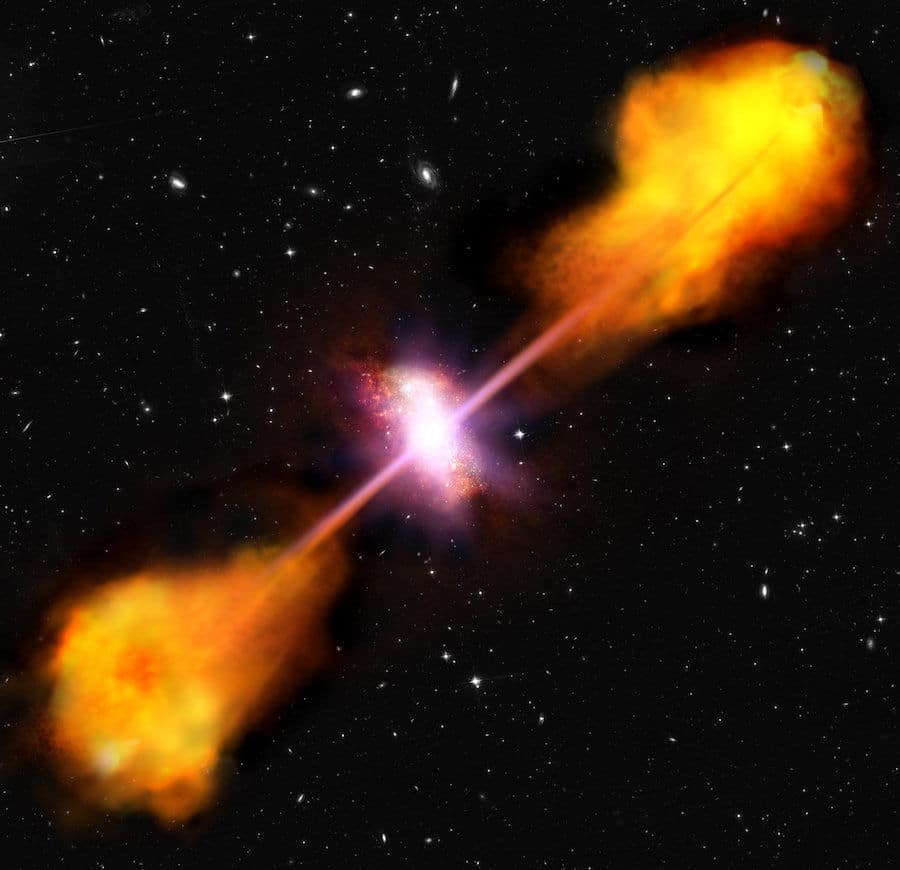
* Type 2 quasars – have their accretion disk and broad emission lines obscured by dense gas and dust.
* Red quasars – they are redder than normal quasars believed to be caused by dust extinction within the quasars host galaxy.
* Optically Violent Variable (OVV) quasars – they are radio-loud quasars in which the jet is directed toward the observer. This results in the rapid variability of the brightness of the quasar. They are also considered to be a type of blazar.
* Weak emission line quasars – they are quasars that have unusually faint emission lines in the ultraviolet/optical spectrum.
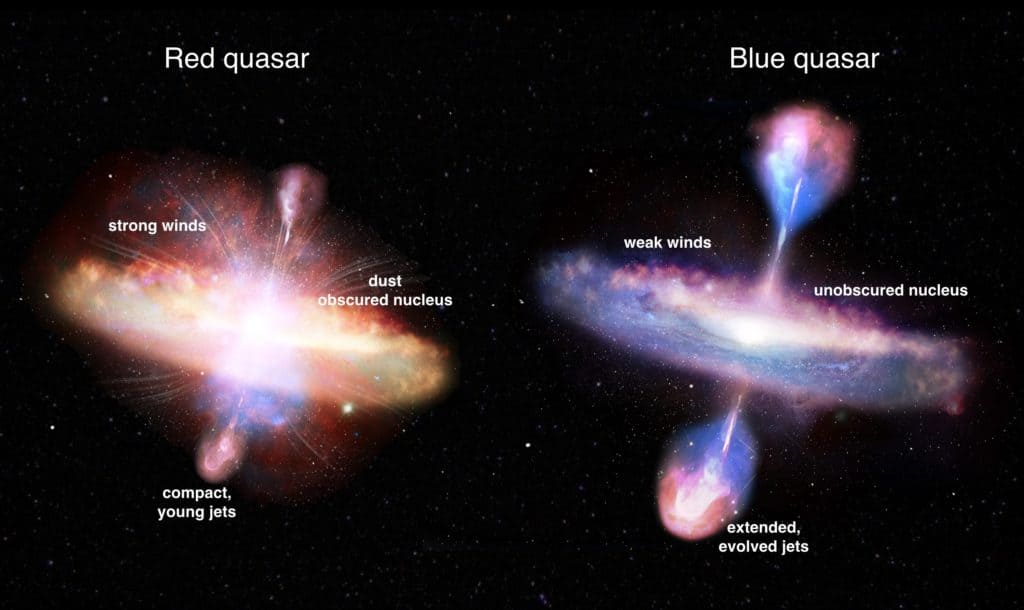
Numbers – Locations
Most of the quasars have been identified by the Sloan Digital Sky Survey. More than 200.000 quasars have already been identified and their spectra redshifts between 0.056 and 7.54. By applying Hubble’s law to these redshifts, studies suggest that these quasars are between 600 million to 29.36 billion light-years away from us, in terms of commoving distance.
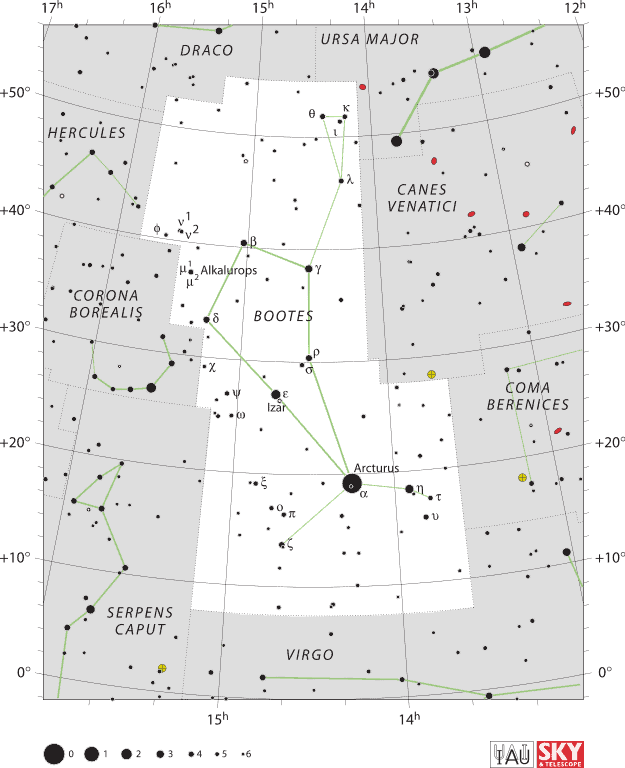
The farthest quasar currently detected is designated ULAS J1342+0928. It has a redshift of 7.54 and the light observed from this quasar was emitted when the universe was just 690 million years old. Behind this quasar, is a supermassive black hole which is estimated to have around 800 million solar masses. It is located in Boötes constellation.
The nearest active quasar detected is designated 3C 273, which is also one of the first discovered quasars. It is around 2.4 billion light-years away from Earth. The black hole behind this quasar is estimated to have around 886 million solar masses. It is located in the Virgo constellation.
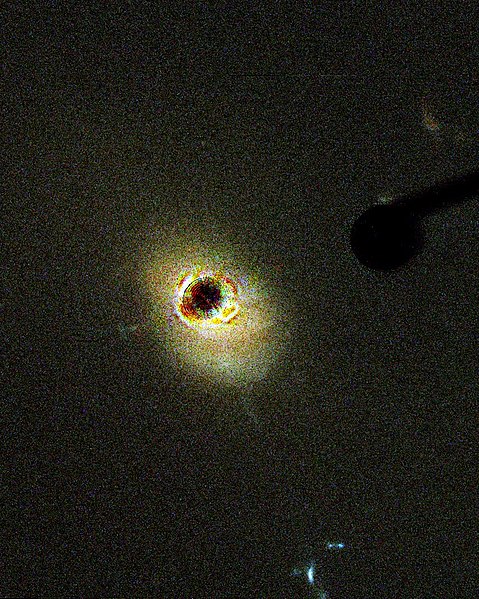
The Future
When the Andromeda and the Milky Way galaxies will collide, it is very likely that a new quasar will be born. Our understanding of quasars is slowly making progress, and in the near future, they could reveal much of the universe’s distant past. Currently, quasars are moving away from us at a speed almost approaching that of light.
Did you know?
- The super-bright quasar, cataloged as J043947.08+163415.7, holds the record of being the brightest quasar in the early universe. It is around 600 trillion times brighter than our Sun.
- The discovery of quasars, in a sense, helped us realize that most galaxies have supermassive black holes at their center.
- The jets emitted by a quasar don’t originate from the center of the black hole. They are emitted from the spinning disc of gas and dust that gradually fell down into the black hole.
- These jets are so powerful that they can extend up to 1.5 million light-years into the stellar space. Because of this, massive hotspots are created which are named DRAGN – Double Radio Source Active Galactic Nucleus.
- Some quasars burn mass every year equivalent to 1.000 solar masses.
- Some of the largest quasars eat up mass equivalent to around 600 Earths every day.
- If quasars would be as common now as they were in the universe’s early beginnings, life would probably cease to exist.
Sources:
Image source:
- https://upload.wikimedia.org/wikipedia/commons/thumb/3/38/Artist%27s_rendering_ULAS_J1120%2B0641.jpg/640px-Artist%27s_rendering_ULAS_J1120%2B0641.jpg
- https://upload.wikimedia.org/wikipedia/commons/thumb/4/47/Bo%C3%B6tes_IAU.svg/625px-Bo%C3%B6tes_IAU.svg.png
- https://upload.wikimedia.org/wikipedia/commons/thumb/1/1b/Quasar_3C_273.jpg/479px-Quasar_3C_273.jpg
- https://upload.wikimedia.org/wikipedia/commons/6/60/PKS_1127-145_X-rays.jpg
- https://www.tech-faq.com/wp-content/uploads/Quasar.jpg
- https://scx1.b-cdn.net/csz/news/800/2016/4-newresearchs.jpg
- https://earth-chronicles.com/wp-content/uploads/2017/12/10458.jpg
- https://ras.ac.uk/sites/default/files/2019-08/Figure%203%20-%20red%20vs%20blue%20quasar%20%28annotated%29.jpg
